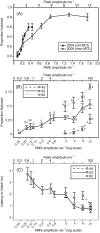The Role of Vibration Amplitude in the Escape-Hatching Response of Red-Eyed Treefrog Embryos
- PMID: 40225269
- PMCID: PMC11986817
- DOI: 10.1093/iob/obaf012
The Role of Vibration Amplitude in the Escape-Hatching Response of Red-Eyed Treefrog Embryos
Abstract
The function and adaptive significance of defensive behaviors depend on the contexts in which they naturally occur. Amplitude properties of predator cues are widely used by prey to assess predation risk, yet rarely studied in the context of the stimuli relevant to defensive decisions in nature. Red-eyed treefrog embryos, Agalychnis callidryas, hatch precociously in response to attacks on their arboreal egg clutches by snakes and wasps. They use vibrations excited during attacks to detect predators, but wind and rainstorms also excite intense vibrations. Past work has demonstrated that to avoid costly decision errors, A. callidryas nonredundantly combine information from the temporal and frequency properties of clutch vibrations. Here, we demonstrate that embryos also use absolute amplitude and fine-scale amplitude modulation information to refine their hatching decision. We used vibration recordings to characterize the amplitude properties of the most common predator and benign-source disturbances to A. callidryas egg clutches in nature and tested whether embryos at 3 ages across the onset of mechanosensory-cued hatching (4-6 days) respond to amplitude variation during playback of synthetic vibrations to eggs. Older embryos responded to much lower-amplitude vibrations, reflecting a >88-fold decrease in response threshold from 4 to 5 days. To assess how embryos combine amplitude with other vibration properties, we played embryos recorded exemplars of snake attack and rain vibrations of varying amplitudes and patterns of amplitude modulation. The amplitude response curve was steeper for snake recordings than for rain. While amplitude information alone is insufficient to discriminate predator attack from benign-source vibrations, A. callidryas employ an impressively complex strategy combining absolute amplitude, amplitude modulation, temporal, and frequency information for their hatching decision.
La función y la importancia adaptativa de las conductas defensivas dependen de los contextos en los que ocurren naturalmente. Las presas utilizan ampliamente las propiedades de amplitud de las señales de los depredadores para evaluar el riesgo de depredación, pero rara vez son estudiadas en el contexto de estímulos relevantes para las decisiones defensivas en la naturaleza. Los embriones de la rana arbórea de ojos rojos, Agalychnis callidryas, eclosionan prematuramente en respuesta a los ataques de serpientes y avispas a sus posturas de huevos arbóreas. Utilizan las vibraciones que se producen durante los ataques para detectar depredadores, pero el viento y las tormentas también generan vibraciones intensas. Estudios previos han demostrado que, para evitar errores costosos de decisión, A. callidryas combina información de las propiedades temporales y de frecuencia de las vibraciones de la postura de forma no redundante. En este estudio, demostramos que los embriones también utilizan la amplitud absoluta e información detallada de modulación de la amplitud para mejorar su decisión de eclosionar. Utilizamos grabaciones de vibraciones para caracterizar las propiedades de amplitud de las fuentes más comunes (depredador y benigna) en causar disrupciones a los huevos en las posturas de A. callidryas en la naturaleza, y evaluamos si los embriones a tres edades distintas desde del inicio de la eclosión con señales mecanosensoriales (4–6 días) responden a la variación de la amplitud durante la reproducción de vibraciones sintéticas en los huevos. Los embriones de mayor edad respondieron a vibraciones de amplitud mucho menor, lo que refleja una disminución de > 88 veces en el umbral de respuesta de 4 a 5 días. Para evaluar cómo los embriones combinan la amplitud con otras propiedades de vibración, reproducimos grabaciones registradas de posturas en ataques de serpientes y vibraciones de lluvia con amplitudes y patrones de modulación de amplitud variables. La curva de respuesta de amplitud fue más pronunciada para las grabaciones de serpientes que para las de lluvia. Si bien la información de amplitud por sí sola es insuficiente para discriminar entre el ataque de depredadores y vibraciones de fuentes benignas, A. callidryas emplea una estrategia impresionantemente compleja que combina información de amplitud absoluta, modulación de la amplitud, información temporal y de frecuencia para su decisión de eclosionar.
© The Author(s) 2025. Published by Oxford University Press on behalf of the Society for Integrative and Comparative Biology.
Conflict of interest statement
The authors declare no competing interests..
Figures




References
-
- Barrio-Amorós CL. 2019. On the taxonomy of snakes in the genus Leptodeira, with an emphasis on Costa Rican species. Reptiles Amphib 26:1–15.
-
- Bradbury JW, Vehrencamp SL. 1998. Principles of animal communication. Sunderland: Sinauer.
-
- Caldwell MS. 2010. The use of vibrational information by red-eyed treefrogs for communication and antipredator defense [dissertation]. Boston (MA): Boston University.
-
- Caldwell MS, Britt KA, Mischke LC, Collins HI. 2022. Beyond sound: bimodal acoustic calls used in mate-choice and aggression by red-eyed treefrogs. J Exp Biol 225:jeb244460. - PubMed
-
- Caldwell MS, McDaniel JG, Warkentin KM. 2009. Frequency information in the vibration-cued escape hatching of red-eyed treefrogs. J Exp Biol 212:566–75. - PubMed
Grants and funding
LinkOut - more resources
Full Text Sources
Miscellaneous
